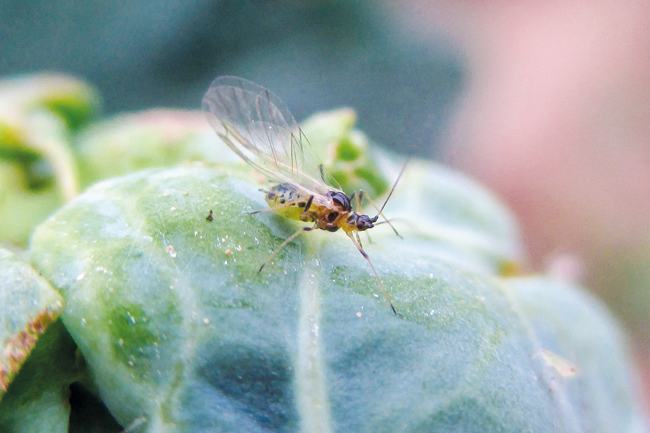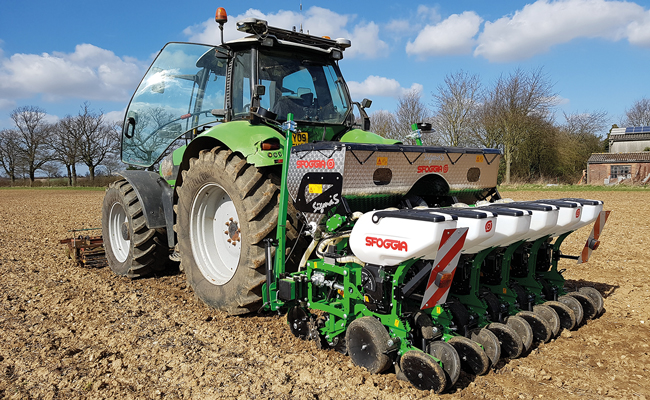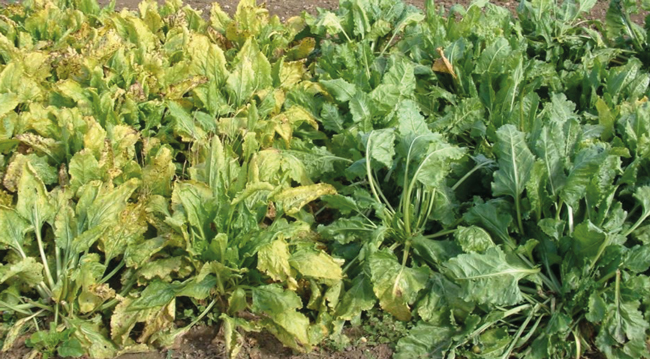Virus yellows warning ahead of new beet season
7th March 2019
Following on from last month’s article in Farmers Guide on growing beet without neonicotinoid seed treatments, Dominic Kilburn attended the BBRO #BeetTech19 conference, Newmarket in Suffolk, where the potential threat of virus yellows was made very clear.
Following on from last month’s article in Farmers Guide on growing beet without neonicotinoid seed treatments, Dominic Kilburn attended the BBRO #BeetTech19 conference, Newmarket in Suffolk, where the potential threat of virus yellows was made very clear.
Without seed treatment protection, in 7 of the previous 17 years, over 50 per cent of the UK sugar beet crop would have “turned yellow”. That was the stark warning from BBRO’s head of Science, Dr Mark Stevens addressing a packed conference venue in early February.
He explained to growers that, for the first time in 25 years, the risk of virus yellows in crops this season was high – with the potential to lose up to 47 per cent yield in badly affected areas.
Should any beet grower need reminding, the 2019 crop going in the ground right now is doing so without neonicotinoid seed treatment protection, since the EU restriction on their use in non-flowering crops, as well as flowering, was extended last year.
As a consequence, the industry is trying to prevent what could be as much as £51m worth of yield losses in high risk areas from damaging virus yellows, transmitted by feeding aphids; the peach potato aphid (myzus persicae) being the main protagonist, explained Dr Stevens.
“The need for protection has never been higher,” he commented. “I’m increasingly nervous this winter as aphids are being seen in large numbers in brassica and cover crops. Last year we got the ‘Beast from the East’ which consequently brought down aphid numbers to a five-year low. And while use of seed treatments protected sugar beet crops from the virus and also reduced the amount of virus out there, it could come back very quickly without them,” Dr Stevens warned.
He said that the BBRO had doubled its aphid trapping and monitoring coverage this year, from 30 to 60 sites, and a complete forecast will be made available in early March for growers to be able to fully understand the risk their crops are facing this season.

Pyrethroids and carbamates should not be used to control aphids – 90 per cent of aphids have resistance to them.
Regular updates on potential risk will be issued via the BBRO’s website, Advisory Bulletin and Twitter feed, he noted.
Options
Dr Stevens pointed out that newly-available Teppeki (flonicamid) is the only chemical option for the control of aphids in sugar beet, with one application permitted up to the 12-leaf stage of the crop.
“Aphid trials at Morley, Norfolk have demonstrated the control benefits of Teppeki and, reassuringly, growers will get up to 21 days protection of their crops once applied at the threshold (1 wingless green aphid/4 plants).
“The problem of course is that aphids could be flying for up to 12 weeks and so timing of the application is important,” he said.
Dr Stevens stressed that pyrethroids and carbamates should not be used to control aphids – 90 per cent of aphids have resistance to them and the chemistry will also knock-out many beneficial insects.
“Once you know aphids are in the area and have exceeded the threshold, then spray with Teppeki at the label rate,” he added.
Dr Stevens advised growers to be aware of spoil heaps and cleaner/loader sites which may be greening up and could provide a green bridge for feeding aphids. Cover crops in the area should also be destroyed ahead of drilling the new crop as these are also known to host virus-carrying aphids.
He said that the BBRO was committed to delivering novel alternative strategies for the control of virus yellows in the future, with a focus on resistant/tolerant varieties, methods for maximising beneficial insects, biocontrol and new, novel agronomy and insecticides.
Changing methods
BBRO’s crop recovery and mechanisation specialist, Stephen Aldis, said that it was clear that growers’ sugar beet establishment methods were changing with increasing use of reduced tillage systems. He said that management of weed seeds through less soil movement, workload benefits and the cost of cultivations are factors influencing change, while there was a desire to drill into sufficient soil moisture, even when faced with unpredictable spring weather.
Examples of strip-till and conventional systems were used to make growers aware of the risk of using a single year’s results to make on farm decisions, while still encouraging on farm trials.
Mr Aldis said that there was still a huge variation in what growers actually drilled compared with their intended target (about 10 per cent either side), and that a simple pre-drilling “back to basics” drill calibration could be the answer.
He also said that use of modern hybrid drills and larger tractors had significantly increased the weight of machinery on the seedbed and growers needed to ensure they had the right machines for the system of establishment they were operating.
While some hybrid drills can offer increased forward speed, it’s important for drill operators to be aware of adjusting drill speed according to a change in soil type, he stressed. “Adjust drill working depth, pressure and forward speed for individual seedbeds.”

Sugar beet establishment methods are changing with increasing use of reduced tillage systems.
Looking to the future, Mr Aldis highlighted establishment technology to help growers get their crops up and away quicker, including real time soil moisture sensors attached to drills to find moisture while planting – automatically adjusting drill operating depth and pressure to place the seed into the moisture, variable rate and ‘variable variety’ systems as well as precision liquid application – applying a measured dose of nutrition per individual seed.
Leaf development
BBRO’s Dr Simon Bowen (right) told delegates that temperature is the most important driver of leaf development (and light interception) in sugar beet – however, sufficient water and nitrogen is also required to maximise the effect. Insufficient levels of either when temperatures are good will slow crop development, he explained.
“In terms of available moisture, while we can’t control rainfall, we can manage soil structure which will influence how much moisture we hold on to,” he said.
“When cultivating, think about what’s happening below the seedbed. Check soils are dry and there is good aggregate structure, good moisture retention and drainage. If the soil is too wet then be patient. Check soils for compaction, particularly below wheels and don’t work soils too fine,” Dr Bowen advised.
He reminded growers that sugar beet is sensitive to soils with a low pH – directly effecting plant development by reducing key nutrient availability.
Low pH will also increase crop susceptibility to soil-borne diseases, he added.
“Make sure nitrogen is applied early enough – at least 30–50kg N/ha at drilling, the remainder by the 4–6th leaf stage of the crop.”
Dr Bowen also stressed that trials have demonstrated that placement of nitrogen (compared with broadcasting) to the side and below the seed can result in a significant benefit in yield. Early nitrogen is driving early canopy development,” he explained.
“Don’t forget sulphur,” reminded Dr Bowen. “Sugar beet on light land not receiving sulphate-based fertiliser or organic manures are at risk from deficiency and backward canopy growth.”
He said that BBRO continues to assess the use of biofoliar applied micronutrients and biostimulants, however trials at three sites in 2018 showed few significant differences compared with untreated controls.
Dr Bowen concluded by advising growers to avoid herbicide damage to the establishing crop. “Know where your different varieties are in terms of growth stages as this will determine the effect of herbicides. Some varieties are more susceptible to herbicides than others, so check product rates and tank mix labels and don’t mix varieties in a field.”
Cover crops in beet
Dr Bowen also posed the question as to whether cover crops worked in a sugar beet rotation.
Trials carried out by the BBRO in 2016/17 and 2017/18 seasons looked at a range of systems across 12 cover crops including plough and min-till, with and without organic manures, single, dual and multi-mix species, and different destruction approaches. These were followed up by BBRO yield dig validations.
Cover crop biomass, rooting, soil compaction, structure, earthworms and nitrogen levels were all measured to determine the effects of cover crops on the soil and on the following beet crop, explained Dr Bowen.
Headline figures from the work show that, in 42 per cent of trials, a 5–10 per cent increase in yield was found in beet crops with a cover crop in the rotation.
Where 2 cover crops featured in the rotation, 60 per cent of crops in trials recorded a yield increase.
“Interestingly, in rotations where a cover crop featured and a min-till regime was operated, 50 per cent of crops registered a yield increase,” Dr Bowen added.
In addition to yield data, observations from the trials included:
- No advantage was seen using multi-mix cover crop species compared with single or double species
- Early drilled cover crops into moisture perform better, producing more of a response in the beet crop
- Higher cover crop seed rates are required in dry conditions
- The inclusion of legumes such as vetch and clover result in higher nitrogen reserves in the soil
- Higher SMN (soil mineral nitrogen) levels, with organic matter, may allow a reduction in applied N
- Cereal cover crop species are suited to shallow soil structuring, while brassicas and phacelia for deeper
- BCN management – a BCN resistant cover crop should be used but removed 5–6 weeks before a BCN tolerant beet variety is drilled
- Earthworm numbers are increased
- Nitrogen lock-up is not an issue where there is a 5–6 week gap to the beet crop being drilled
- Destruction: sheep grazing works well; desiccation and crimping need more careful timing
“There’s no doubt that cover crops are a tool in the sugar beet rotation but there isn’t a blueprint as to how to get the maximum benefit. Growers will have to figure that out and it’s also worth remembering that they need a long-term approach,” concluded Dr Bowen.

